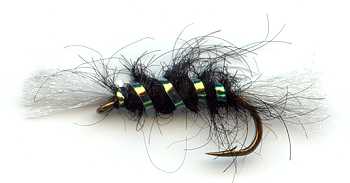Black Shipman's Buzzer Midge Emerger
The early season hatches of black midges on my local river are far too small to match individually with an imitation dry fly.

SHIPMAN'S BUZZER (CHIRONOMIDS) MIDGE EMERGER NYMPHS FLY PATTERNS. Hook size 10 12 14 - $US each
Like mayflies midge pupa spend most of their life as nymphs grubbing around in the debris on the bottom of streams, rivers and lakes until they are mature enough to rise to the surface and hatch. They take to the air within seconds of emerging and swarm in columns of black clouds of insects above the water and nearby vegetation.
If they come near, you have to remember to close your mouth otherwise you will be spitting out small black insects that have tried to explore the back of your throat, for the next 10 minutes. So are these tiny insect of interest to the flyfishing angler? Individually the answer is no, but when they moult and become their equivalent to a mayfly spent spinner and fall exhausted to the water surface after mating then yes. Wind and surface currents push these tiny floating bodies towards the bankside. Here they group together in clumps as parts of wings and tails intertwine with others.
These clusters are now worth a rainbow or brown trout’s effort to follow and slurp down. They can be formed by five or more midge bodies trapped in the surface film. Examine the color of the midge spent spinner bodies and match it with a Shipman’s buzzer midge dry fly pattern. This fly is a good general imitation of a collection of tiny surface floating midge spent spinners. Cast your Shipman’s Buzzer upstream and allow it to dead drift with the current along the bank. Do not allow your line to go tight. It must be drag free otherwise you are in danger of spooking the trout. The group of insects your fly is trying to imitate are dead. The trout do not expect their expired food to suddenly come back to life with superpowers and start swimming against the current.
Black Shipman’s Buzzer fished on the river Wye
The River Wye starts in the Welsh Cambrian hills and enters the Seven estuary near Chepstow. It is an excellent stonefly stream in its upper reaches. Smaller needle and willow flies together with the medium stonefly often appear on the water. They may not appear in immense numbers but enough to attract hungry fish.
The evening caddis hatches are not great, but are compensated for by the often magnificent falls of upwinged mayfly spinners and the tremendous hatches of blackflies (reed smuts) and aquatic midges. The latter can be frustrating, for the trout take these minute natural flies in or just below the surface film.
Deceiving the fish with a high floating dry artificial is often difficult. My fly of choice during periods when the trout are feasting on these tiny black flies is to use a Black Shipman’s Buzzer as it is a great imitation of a bunch of these tiny flies that have floated together in a group. It does not ride high like normal dry flies. Just let it float on the surface.
One pool in the meadow just above Bakewell has scores of feeding fish within casting range on any warm evening from late April to September, but catching them is another matter. If you plan to visit the river Wye make sure that you have a lot of small hook dry flies, duns, spinners and emergers, from size 16 down to 24.Too many visitors make the mistake of using flies that are too large. A size 14 mayfly dry fly pattern is too big for these waters.


Fly Fishing books

